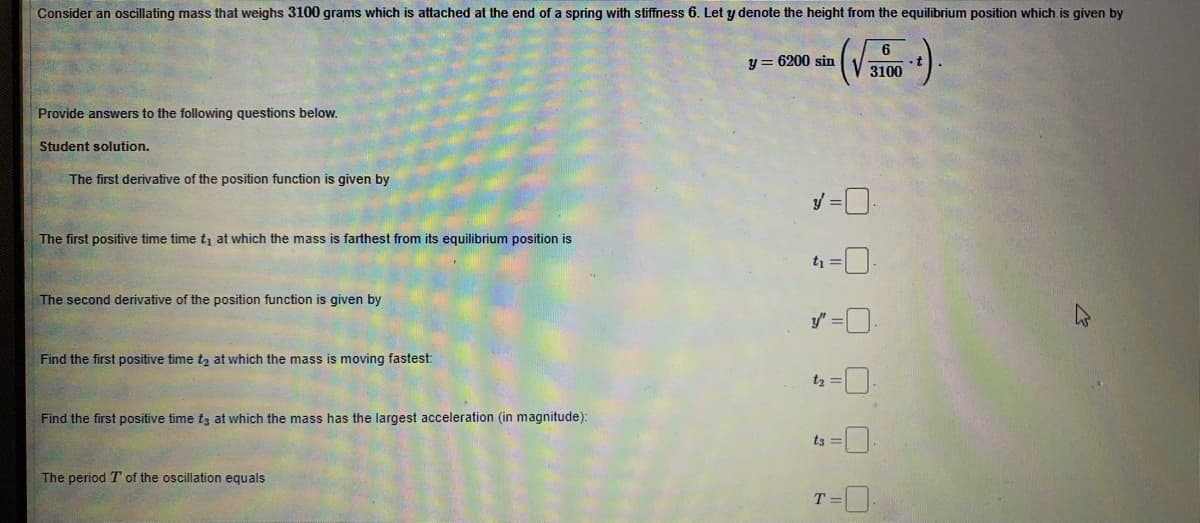Consider an oscillating mass that weighs 3100 grams which is attached at the end of a spring with stiffness 6. Let y denote the height from the equilibrium position which is given by y = 6200 sin 3100 Provide answers to the following questions below. Student solution. The first derivative of the position function is given by The first positive time time ti at which the mass is farthest from its equilibrium position is The second derivative of the position function is given by
Consider an oscillating mass that weighs 3100 grams which is attached at the end of a spring with stiffness 6. Let y denote the height from the equilibrium position which is given by y = 6200 sin 3100 Provide answers to the following questions below. Student solution. The first derivative of the position function is given by The first positive time time ti at which the mass is farthest from its equilibrium position is The second derivative of the position function is given by
Calculus: Early Transcendentals
8th Edition
ISBN:9781285741550
Author:James Stewart
Publisher:James Stewart
Chapter1: Functions And Models
Section: Chapter Questions
Problem 1RCC: (a) What is a function? What are its domain and range? (b) What is the graph of a function? (c) How...
Related questions
Question

Transcribed Image Text:Consider an oscillating mass that weighs 3100 grams which is attached at the end of a spring with stiffness 6. Let y denote the height from the equilibrium position which is given by
y = 6200 sin
3100
Provide answers to the following questions below.
Student solution.
The first derivative of the position function is given by
The first positive time time t, at which the mass is farthest from its equilibrium position is
The second derivative of the position function is given by
Find the first positive time tz at which the mass is moving fastest:
Find the first positive time t3 at which the mass has the largest acceleration (in magnitude):
ts:
The period T of the oscillation equals
T=.
Expert Solution
This question has been solved!
Explore an expertly crafted, step-by-step solution for a thorough understanding of key concepts.
Step by step
Solved in 4 steps with 4 images

Recommended textbooks for you

Calculus: Early Transcendentals
Calculus
ISBN:
9781285741550
Author:
James Stewart
Publisher:
Cengage Learning

Thomas' Calculus (14th Edition)
Calculus
ISBN:
9780134438986
Author:
Joel R. Hass, Christopher E. Heil, Maurice D. Weir
Publisher:
PEARSON

Calculus: Early Transcendentals (3rd Edition)
Calculus
ISBN:
9780134763644
Author:
William L. Briggs, Lyle Cochran, Bernard Gillett, Eric Schulz
Publisher:
PEARSON

Calculus: Early Transcendentals
Calculus
ISBN:
9781285741550
Author:
James Stewart
Publisher:
Cengage Learning

Thomas' Calculus (14th Edition)
Calculus
ISBN:
9780134438986
Author:
Joel R. Hass, Christopher E. Heil, Maurice D. Weir
Publisher:
PEARSON

Calculus: Early Transcendentals (3rd Edition)
Calculus
ISBN:
9780134763644
Author:
William L. Briggs, Lyle Cochran, Bernard Gillett, Eric Schulz
Publisher:
PEARSON

Calculus: Early Transcendentals
Calculus
ISBN:
9781319050740
Author:
Jon Rogawski, Colin Adams, Robert Franzosa
Publisher:
W. H. Freeman


Calculus: Early Transcendental Functions
Calculus
ISBN:
9781337552516
Author:
Ron Larson, Bruce H. Edwards
Publisher:
Cengage Learning